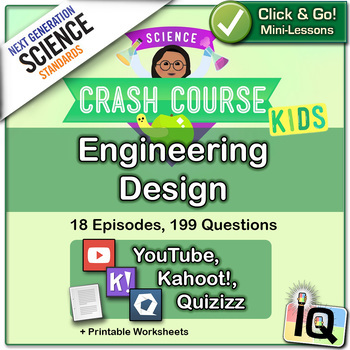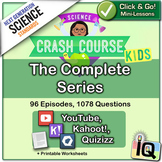Crash Course Kids, Engineering Design | Digital & Printable
- PDF
- Internet Activities
What educators are saying
Also included in
- Learn about Earth’s Systems, Ecosystems, Forces, Matter, and more! Point and Click for instant Science Mini-Lessons with Game-Based Assessment using Quizizz and Kahoot!• This ZIP file contains all nine of my Crash Course Kids Science IQ products, previously published individually, PLUS a compiled PDPrice $29.99Original Price $40.46Save $10.47
Description
Learn about The Engineering Process, Variables, Failure Points, and more!
Point and Click for instant Engineering Mini-Lessons with Game-Based Assessment using Quizizz and Kahoot!
• This PDF document includes organized hyperlinks to educational video content and digital interactive quizzes. Optional printable worksheets are included.
• For each YouTube episode, the quiz is available using two separate platforms: Kahoot and Quizizz. Every multiple-choice question includes a related screenshot from the video (images used with permission).
• Students can use any internet connected device, working individually or in groups, to input their responses.
Crash Course Kids Episodes:
#1 - What's an Engineer? (What engineers do and why they do it)
#2 - The Engineering Process (Why we should do things in order)
#3 - Defining a Problem (What problems we want or need to solve)
#4 - Defining Success (How Engineers look at results)
#5 - Got Some Solutions? (Coming up with multiple solutions)
#6 - Let's Fly! (How to select the best solution)
#7 - A Case of "What-Ifs" (Understanding variables)
#8 - Engineering Games (Games can teach us about engineering)
#9 - Bowled Over - Isolating Variables (Getting reliable results)
#10 - Try Trials (Figuring out what the problems are)
#11 - Succeed by Failing (Describing failure points)
#12 - Fixing Failure Points (Setting up models and trials)
#13 - Designing a Trial (Testing situations in the real world)
#14 - Testing and Trials (Dealing with limitations)
#15 - The Robot Challenge (Building an awesome robot)
#16 - Architecture Adventure (A special kind of engineering)
#17 - Let's Build a City (Engineering something huge)
#18 - The End Is Only The Beginning (A tour of ideas)
The Crash Course videos and Interactive Quizzes in this series are aligned with the following Grade 5 Performance Expectations and Disciplinary Core Ideas of the Next Generation Science Standards*:
3-5-ETS1-1 Engineering Design
Define a simple design problem reflecting a need or a want that includes specified criteria for success and constraints on materials, time, or cost.
3-5-ETS1-2 Engineering Design
Generate and compare multiple possible solutions to a problem based on how well each is likely to meet the criteria and constraints of the problem.
3-5-ETS1-3 Engineering Design
Plan and carry out fair tests in which variables are controlled and failure points are considered to identify aspects of a model or prototype that can be improved.
ETS1.A: Defining and Delimiting Engineering Problems
Possible solutions to a problem are limited by available materials and resources (constraints). The success of a designed solution is determined by considering the desired features of a solution (criteria). Different proposals for solutions can be compared on the basis of how well each one meets the specified criteria for success or how well each takes the constraints into account. (3-5-ETS1-1)
ETS1.B: Developing Possible Solutions
Tests are often designed to identify failure points or difficulties, which suggest the elements of the design that need to be improved. (3-5-ETS1-3)
ETS1.C: Defining and Delimiting Engineering Problems
Different solutions need to be tested in order to determine which of them best solves the problem, given the criteria and the constraints. (3-5-ETS1-3)
***************************************************************************
WAIT! You can also buy this product in my "Complete Series" Bundle:
Crash Course Kids, Science - The Complete Series, Bundle
***************************************************************************
Links to Interactive Quizzes in the same Series:
Crash Course Kids, From Molecules to Organisms - Free Sample!
Crash Course Kids, Earth and Human Activity
Crash Course Kids, Earth’s Place in the Universe
Crash Course Kids, Earth’s Systems
Crash Course Kids, Engineering Design
Crash Course Kids, Forces and Interactions
Crash Course Kids, Matter and Its Interactions
Crash Course Kids, Science - Solo Play with QR Codes
***************************************************************************
How to Use the Interactive Quizzes:
Rich Colosi has created introductory videos on both the Kahoot and Quizizz platforms:
Kahoot! For Teachers - Rich Colosi Media on YouTube
Quizizz For Teachers - Rich Colosi Media on YouTube
***************************************************************************
Did you know ...?
• Each time you give feedback on a product, TPT gives you feedback credits that you use to lower the cost of your future purchases. Feedback to TpT Sellers, just like feedback to students, is a valuable tool to aid improvement of future products. Go to your "My Purchases" page to view past downloads, and provide a rating and comment.
• You can be the first to know about new discounts, freebies and product launches. Look for the green star next to the TpT store logo and click it to become a follower and receive email updates about the store.
***************************************************************************
* Next Generation Science Standards (“NGSS”) is a registered trademark of Achieve. Neither Achieve nor the lead states and partners that developed the Next Generation Science Standards were involved in the production of this product, and do not endorse it.






